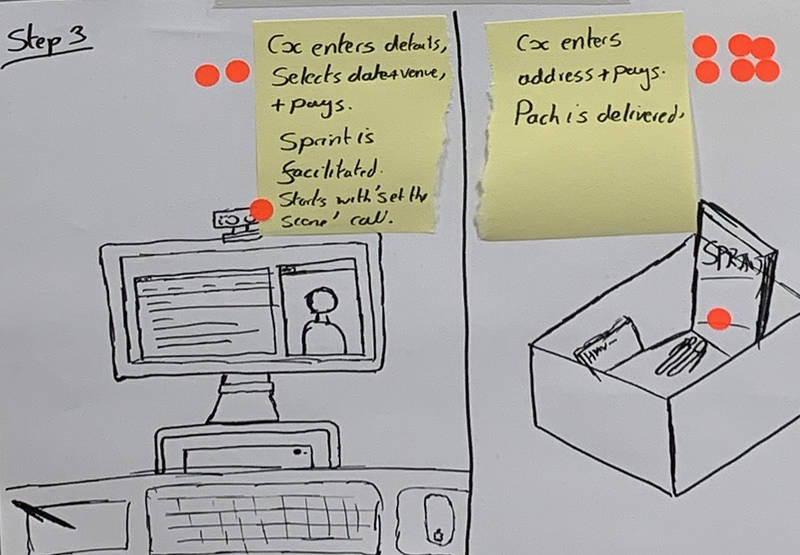Sticky Decision - The Design Sprint Unpacked
Sixty Second Summary
In this series, we’re taking a look at the individual parts which make up a Design Sprint, how each part helps us work towards a user-tested prototype, and how you can use the activity on its own within your business’s Design-led decision making process.
Taking place the morning after your four-part sketches, the Sticky Decision activity is actually made up of 5 sub-activities to get your Sprint Team to decide on which areas you’ve covered in your ideas to take to prototyping - all in just 90 minutes.
Full Article - 3 Minute Read
A Sticky Decision
In the Four-Part Sketch, we created and refined a lot of ideas in a relatively short period of time. Now, in just 90 minutes, it’s time to review the final Concept Sketches everybody came up with - either in the room or as homework - and make a decision about which aspects of the concepts we’ll be prototyping.
For this session, it makes sense for the Decider to be in the room for the whole session.
Art Museum
The first thing to do is put up all of the Concept Sketches somewhere they can be seen by everyone in the Sprint Team. This is typically on the wall or whiteboard, if you’re running a traditional Design Sprint, but can be on an online platform when running a Remote Design Sprint.
What’s important is that the author of each sketch is kept anonymous, so that the upcoming votes are free of social pressure and influence. We’re here to find and test the best ideas, not to test the ideas of those in the room who have the most influence. This can be achieved by asking everyone to submit their sketch at once, and then shuffling up the pile before placing them on the wall.
Tool Tip
If you are hanging up the Concept Sketches on the wall, we recommend using (mt) Washi Tape to do so. A specific kind of masking tape, Washi Tape is strong enough and long-lasting enough to keep the Sketches on the wall for the rest of the sprint, but also is unlikely to damage the paint or whiteboard when removed.
Heat Map
Once all of the Concept Sketches are up on the wall, it’s time to give everyone some voting dots and 15 minutes to go through the sketches and silently vote on their favourite parts from each sketch. You may decide to limit the number of voting dots per person, but you can give an unlimited number, as the time is limited and people will tend to self-limit on their voting anyway.
As the Sprint Team looks over all the sketches, ask them to put 1-3 dots on their favourite parts from the sketches. One dot means they find the idea interesting, three dots mean they find it very interesting and think it should be something that’s explored.
After the 15 minutes, you’ll have a series of sketches with sticky-dot heat maps of the features people in the Design Sprint think are important and relevant.

Speed Critique
Now that everyone has voted on their favourite parts of the Concept Sketches, it’s time to test the Facilitator’s improvisational skills. Spending three minutes on each sketch, the Facilitator goes around the room and discusses the highlights of each sketch with the room, as if they were presenting the ideas to a panel of judges.
During this time, the facilitator and the team can capture ideas and objections related to each sketch, before reviewing with the sketcher to check if there’s anything about the idea that has been missed or misunderstood. This will, hopefully, be the first time that people know who drew what.
Straw Poll
Once the Speed Critique is completed, it’s time to run a quick Straw Poll with the whole team to see which of the covered ideas is their favourite. Each person on the Sprint Team is given one large voting sticker and, at the same time as everyone else and in complete silence, must put their voting sticker on their FAVOURITE idea from all of the ideas presented.
Supervote
Once everyone has voted in the Straw Poll, it’s time for the Supervote, which is one of the sessions during the Sprint where the Decider needs to be present. The Decided is given three large voting dots, each with their initials on, and is asked to choose THREE parts from the concept sketches that they want to bring forward into prototyping.
Though their decision will likely be influenced by the straw poll which happened earlier, it does not have to be. The Decider may know something or see something that influences their decision away from the group. In all cases, the Decider’s decision is final and those components they have Supervoted will be prototyped.
Insights and Inspiration
Sign up to our email newsletter for monthly insights, inspiration, tips and special offers. We’ll never give your contact details to anyone else, they’ll be used only send you our newsletter.
Changes for a Remote Design Sprint
When you come to do this activity as part of a Remote Design Sprint, you will need to use a tool where everyone’s images can be anonymously uploaded and voted on. At The Familiar, we use and recommend Mural for this online collaboration, as it allows all of the Concept Sketches to be seen and reviewed at once.
But, at the time of writing this, Mural has one limitation when it comes to the Sticky Decision - you can’t vote on a specific part of an image, only on the image itself, if you’re using the built-in voting. That means that you’ll need to draw some circles or similar for each person to use for voting, copying and pasting them onto the areas they wish to vote for.
Next Article
Now we’ve covered the method to select ideas from our Concept Sketches. Next time we will look at what we should do with all those winning ideas - and the other great ones that we’ve generated.
